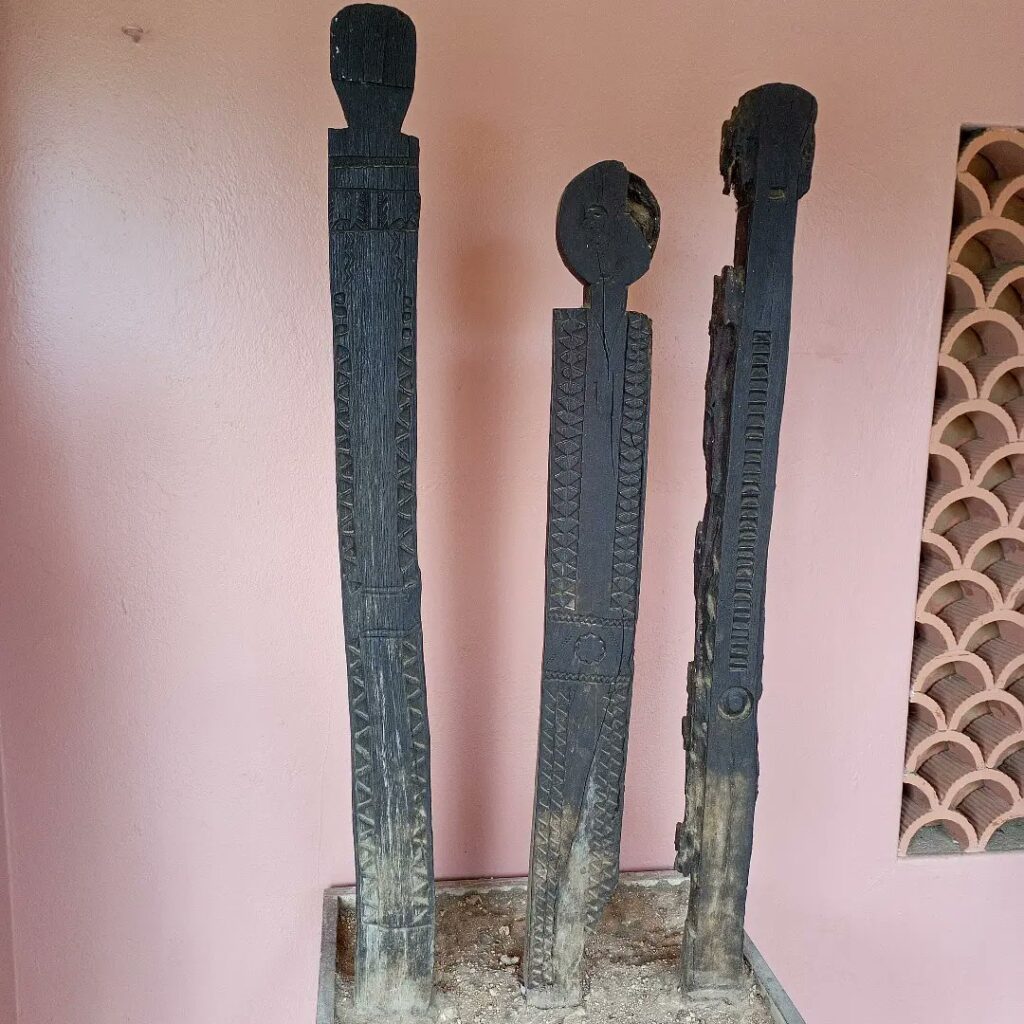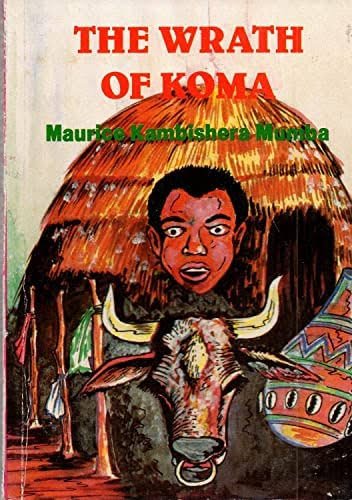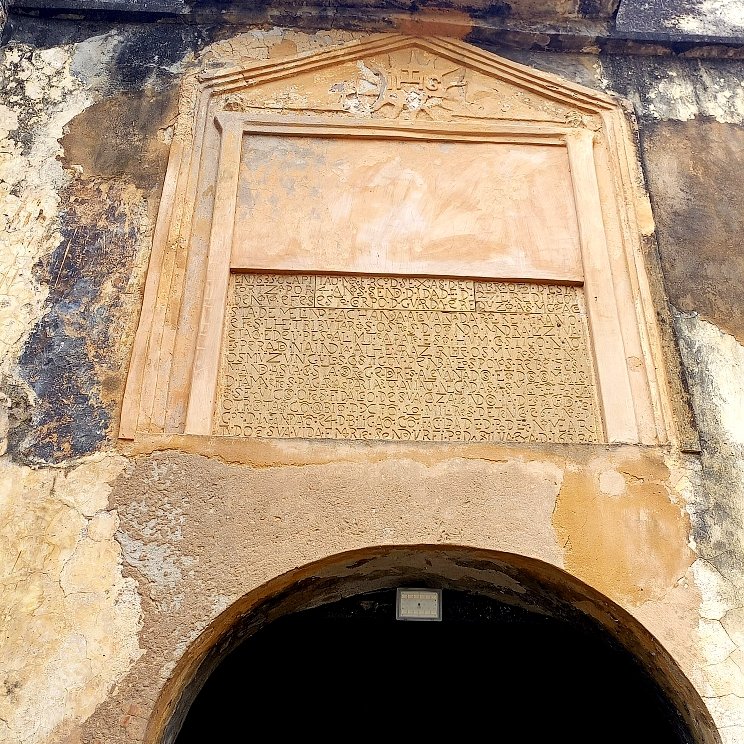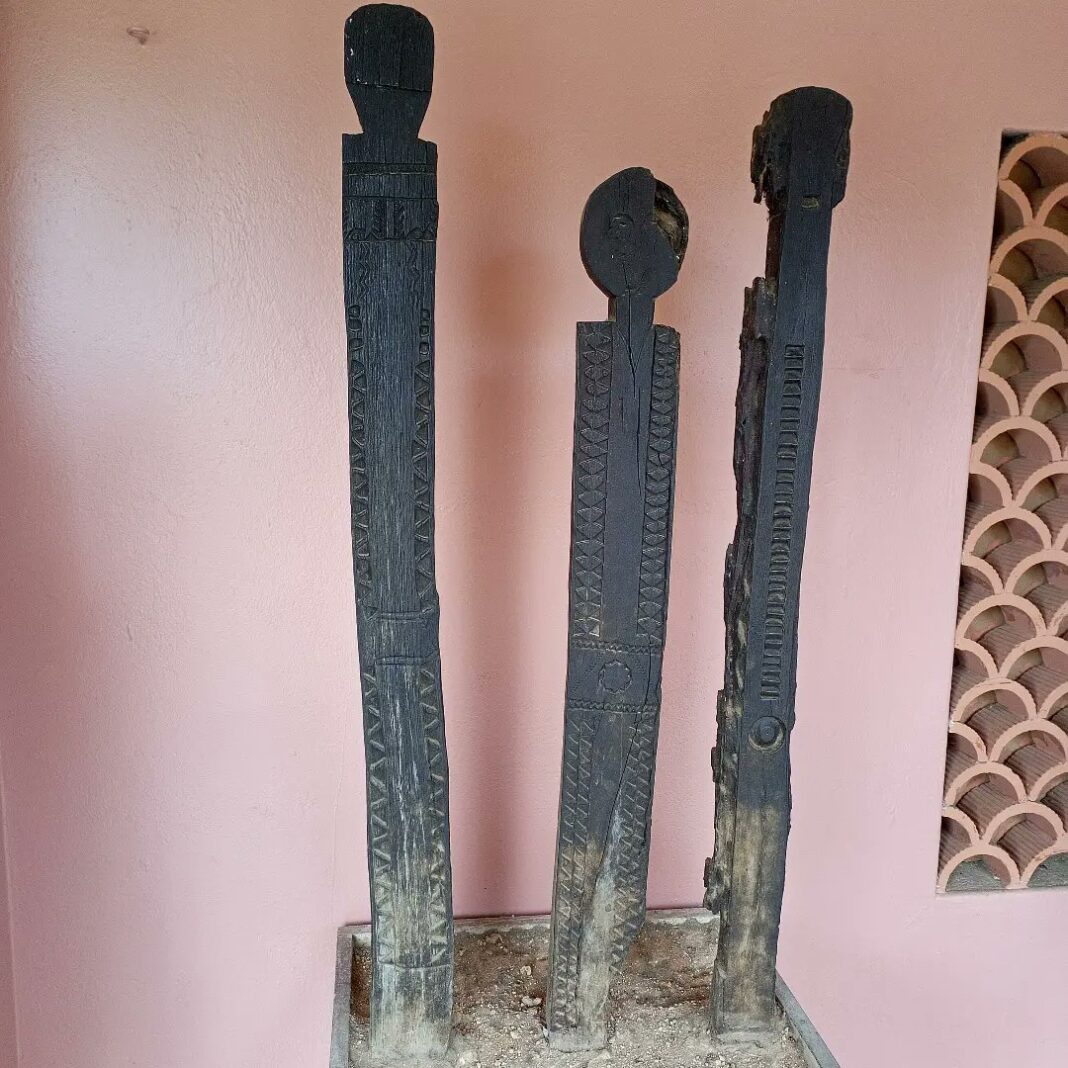In Kenya’s coastal region exists a Bantu ethnic group called the Mijikenda. They comprise nine distinct sub-tribes, namely; Giriama, Kauma, Chonyi, Jibana, Kambe, Ribe, Rabai, Duruma, and Digo. Each sub-tribe has its own language, customs and tradition, but they also share similarities in cultural practices and beliefs. One such similarity is their belief in the afterlife and veneration of their ancestors. The Mijikenda believe that ancestors continue to exist in the spiritual realm after they have passed on and maintain a spiritual connection to the world of the living. The ancestral spirits are seen as intermediaries capable of interceding on behalf of their living descendants during troubled times and when seeking blessings for a forthcoming season or event. Central to these beliefs are sacred forests that the Mijikenda call Kaya, which can be loosely translated to mean ‘home’. Each Mijikenda sub-tribe is associated with its own Kaya. Most historians estimate the Kaya to have been demarcated in the sixteenth century, around the time most Mijikenda are said to have migrated to their present abode. The Kaya served as settlements, fortified sanctuaries during times of war or social upheaval, and as the focal point of worship for the Mijikenda. As places of worship, the Kaya also house cultural artifacts that are of great spiritual value to the Mijikenda. At designated areas within the Kaya, specifically where these artifacts are housed, visitors cannot set foot while wearing shoes because it is sacred ground. Even Kaya elders themselves have to dress appropriately while in the area, a testament to how ancestral spirits are revered by the Mijikenda.
The most significant of these cultural artifacts are vigango (singular: kigango). Vigango are wooden objects erected as commemorative posts to honor dead Mijkenda elders who were part of the sacred Gohu society. Membership to the Gohu society was reserved only for men who were carefully selected for their wisdom, experience and ability to pay membership fees (mainly livestock). Vigango are different from ‘koma’ statuettes. Koma is the wider name for spirits among the Mijikenda, as well as commemorative posts erected for departed ordinary Mijikenda ancestors. Koma statuettes can be erected for both male and female ancestors and are dressed to indicate the gender of the ancestor who passed on. While koma statuettes are not overly-elaborate and are carved from ordinary wood, vigango are carved from hard termite-resistant wood from the sacred Kaya forests and bear intricate designs and motifs depicting the departed elder’s achievements and status within the community. When a Gohu society member died, his family informed the Gohu council and commissioned them to carve a kigango in his honor. A big feast then accompanied the installation of the kigango. There are some noticeable artistic differences in vigango from different Mijikenda sub-tribes. For instance, vigango among the Chonyi have a well-defined head with well-formed features. Kambe and Giriama vigango are stained with local dyes, charcoal or red ochre. The one similarity in all vigango from different Mijikenda sub-tribes are the small triangular shapes that are visibly evident in the designs. The triangular shape is said to be a symbol of synchronized harmony between the ancestors, the living and the spiritual realm.

Both koma statuettes and vigango are believed to have the potential to cause harm when not respected. A 1989 book, The Wrath of Koma by Maurice Kambishera Mumba, gives a fictional account of the kind of harm that can meet those who go against koma. In the book, a character
called Chembe is an old member of the Kauma sub-tribe of the Mijikenda. After his son Dundu goes mad, he travels far to find a famous medicine man called Mokoli Mwiru. There, Mokoli tells him that his son is under the wrathful attack of koma. The spirits are resentful towards old Chembe and his family for the ingratitude towards them after Dundu was born after their intercession. What follows is a prescribed ceremony of appeasement to heal Dundu. In one fictitious yet culturally inspired account, we learn of the kind of reverence the Mijikenda had for the spiritual realm. While the younger generations may have lost touch with that culture, there are no guarantees that the spirits themselves have disconnected themselves from the ability to effect blessings or harm on ‘ignorant’ or indifferent descendants. As they say, ignorance is no defense. A lot of the disconnect came from embracing modern forms of religion, neglecting our ways as backward and as forms of idol worship that undermine the one true God. The latter take could not be more wrong. The Mijikenda phrase ‘Koma tsi Mulungu dzulu’ and in Swahili ‘Koma chini, Mungu juu’ means the spirits are on the ground and God is above. The literal translation is that God is more supreme to the spirits, meaning that the spirits or koma only serve as a means of intercession to God and also as remembrance posts to the living. Not very different from the concept of patron saints in Christianity. And if patron saints still have a place in mainstream religion, so too do koma.

As a historian, cultural curator and digital archivist maternally linked to the Mijikenda people of Kenya, the subject of vigango is one close to my heart. In particular, the return of a number of vigango that unethically found their way to the West, their repatriation and what should happen to them upon their return. There is no sure way of knowing how many vigango were stolen from the Mijikenda over the years but the greatest documented cultural heist of vigango took place in the 1980s. Hundreds (probably more) of vigango were stolen and sold to tourists and international collectors. Of course, this did not happen without the assistance of some unscrupulous locals. Unemployed youth got into the business of looting vigango, which they sold to owners of curio shops in Mombasa and other towns for around US$ 50. The curio shop owners in turn sold them to Western art dealers for between $ 100 and $ 300. This was an absolute steal for the art dealers who ultimately sold the vigango for up to $ 4,000 in Western art markets in those days. The vigango have since been discovered in private art collections and museums throughout Europe and the United States.
The Mijikenda consider vigango thieves social outcasts and at the height of their looting, Mijikenda elders called for anyone apprehended to face similar charges to killing another human being. Of course, such measures were never adopted, not even on a lesser scale, thanks in no small part to the lukewarm nature of the Kenyan government itself towards self-cultural preservation. This can be seen in the congratulatory message of the then Kenyan Ambassador to the United States, on behalf of Kenyan President Moi, upon an exhibition of vigango by Ernie Wolfe in Washington. Ambassador John P. Mbugua stated: ‘These beautiful pieces in the exhibition and the catalogue depict and represent traditional thinking and the lifestyle of our people. Because in the past, the peoples of Kenya and many other parts of Africa did not possess a written history, these past generations communicate to the living through their many forms of art and crafts. It is therefore gratifying to see such works being exhibited in the capital of the United States.’ Ernie Wolfe is often named as the single-most pivotal entity for the vigango market in the United States. It is thus clear that the Kenyan government, mostly for lack of understanding and appreciation of Mijikenda culture, enabled this sacrilege. According to Wolfe himself, his actions were not unethical. He says the vigango he collected, sold or exhibited had ‘spent’ their spiritual powers and had already been abandoned by their consecrators. And therein lies the problem: his interpretation.
Wolfe interpreted things merely on face value. It is true that once a village relocates to another area, maybe in search of more fertile land, that the existing vigango are left behind. It is also true that upon relocation, replacement statues called vibao are erected in the new village in place of the vigango left behind. The vibao bear no elaborate designs but are believed to carry the same spiritual power that the original vigango carried, once a ritual ceremony of their erection is performed. The ceremony is meant to appease the vigango in the previous area of occupancy and to officially transfer spiritual power to the new vibao. Wolfe takes on board just one bit of the whole process to use in the defense of his trade, the abandoning of the vigango and the transfer of spiritual connectivityto the new vibao. He however ignores the whole purpose of leaving the vigango behind in the first place: that the dead and the spirits of the dead are not to be disturbed. The ‘abandoned’ vigango were respected enough by the Mijikenda to be left behind to naturally decay, undisturbed,just like human remains. The Mijikenda also believe that with the deterioration of vigango, the spirits of the ancestors are allowed to continue their journey in the afterlife, ultimately being allowed to rest when the vigango have completely disintegrated. Wolfe’s misinterpretation is the same one adopted by the private art collectors and museums that purchased the vigango or accepted their donation; that they looked abandoned. That a ritual ceremony was performed to transfer their power does not relieve them of the spiritual manifestation and purpose they initially bore. Many people have relocated from their ancestral homes but they do not dig up the remains of their buried ancestors to relocate with them. Neither do new occupants of an area go scouting for past graves in the area unless they stumble on them by accident. In the same breath, the vigango left behind should have been left where they were. The purpose of transferring the spiritual power to the new vibao was because the medium of connection to the spiritual world had to be physically present and in close proximity to the community.
With the wider awareness of stolen cultural artifacts and their restitution that is present now, the government of Kenya needs to actively take up the campaign for the return of all vigango held outside the country. Furthermore, the government needs to make diplomatic arrangements and create legislation to ease the return of cultural artifacts belonging to our people, not just vigango belonging to the Mijikenda. At the time when most of the vigango were looted from the country, it was not illegal to export them, nor was it illegal for someone in the United States to import them. It is that legal loophole that has allowed some of the vigango to be considered private property, with the ‘owners’ being under no obligation to return them home. But there has been progress, in 2014 the Denver Museum of Nature and Science resorted (thanks to Steve Nash, Director of Anthropology and Curation at the Museum) to return the thirty vigango they held; they were considered art pieces subject to a Kenyan import tariff of $ 40,000. It only took the intervention of Dr. Purity Kiura of the National Museums of Kenya to have the Kenya Revenue Authority waive the tariff. Upon their return in 2019, the next struggle was what to do with them. There is no database to show where the vigango were taken from. It would have been easy to retrace them by their artistic design to their respective Mijikenda subtribe’s Kaya but not all vigango were erected in the Kaya, some were in homesteads that were later migrated from. Most were erected at the center of respective homesteads as the Mijikenda people moved from Kaya settlements to other expansive and fertile areas. For lack of an ability to trace where they were stolen from, the returned vigango are now housed at Fort Jesus.
The choice of Fort Jesus as a housing site is itself troublesome. The Fort, or Ngomeni as the locals call it, divides opinion. The Fort was built by the Portuguese to safeguard their strategic interests on the Swahili coast. Its strategic position near the sea allowed the Portuguese to monitor any oncoming threat from the sea. It also meant that the Fort could be resupplied and restocked from the sea, thus increasing its logistical advantage by being able to sustain any attacks by way of the land for long periods. Overall, it was an important administrative center to oversee Portuguese operations in the region. Now a popular tourist destination, it is also a reminder of what it took to build such a fortress. Local tour guides at the Fort will tell you it took three years (1593-1596) of whippings and meager food for the local labor force to build it. That it is celebrated as a Portuguese wonder of architecture overshadows the inhumane cost of building it. Add to that the Portuguese inscription on the outer gate of the Fort chronicling a brutal four-year tenure of Francisco de Seixas de Cabrien as Captain of the Fort and we have all the ingredients for locals to feel detached from the Fort. The inscription reads:
‘In 1635, Francisco de Seixas de Cabrien, aged 27
years, was made for 4 years Captain of this Fort,
which he had reconstructed and to which he added
his guardroom. He subjected to His Majesty the
people of the coast who, under their tyrant king, had
been in a state of rebellion. He made the Kings of
Otondo, Manda, Luziwa and Jaca tributary to His
Majesty. He inflicted, in person, punishment on Pate
and Siyu, which was unexpected in India, extending
to the destruction of their town walls. He punished
the Musungulos and chastised Pemba, where in his
own responsibility he had the rebel governors and all
the leading citizens executed. He made all pay tribute
to His Majesty those who had neglected to pay it.
For these services he was made a knight of the Royal
Household after he had already, for other services,
been given the habit of the Order of Christ and a
yearly grant of fifty milreis and the governorship of
Japanapatan for six years, and of Belgao for four
years, with the right to make all appointments during
his life and in the event of his death. During the Vice
royality of Pedro da Silva in the year of our Lord 1639.’

The mention of Musungulos/Muzungulos is a direct reference to the Mijikenda. James Kirkman in The Muzungulos of Mombasa infers the term Muzungulos came from the Swahili word zunguka meaning to wander. Which is what the Muzungulos could have been known for by the Swahili living on the coast in the sixteenth century. They are first mentioned by the Portuguese in 1611, and this could be because historians estimate the Mijikenda migration from Shungwaya to have happened in the second half of the sixteenth century. The mention of them ultimately settling in the areas between Mombasa and Kilifi and south of Mombasa casts no doubt that the Muzungulos are actually the Mijikenda. This thereby makes the inscription on the outer gate of Fort Jesus an acknowledgement of the punishment of the Mijikenda, certainly not a worthy place to house Mijikenda vigango or a central point of celebrating their return.
Most Kaya were completely abandoned as settlements in the 1940s and left to the care of Kaya elders as modernization and migration to urban areas became common phenomena. While this presented a switch in outlook of the Kaya from a human settlement to a heightened spiritual territory, it also birthed a disconnect between the younger generations and their culture. Some things like the vigango sacrilege can only happen when the people are disconnected from their past and attach no value to culture. Who’s to say that some of the problems the Mijkenda currently face cannot be attributed to unappeased spirits, some whose vigango were unceremoniously detached from the community they existed in? Retracing the repatriated vigango to their respective families or homesteads is near impossible but the next best alternative is to have them erected in a Kaya with rituals like those of reinterment performed by Mijikenda elders. In 2019, Steve Nash, of the Denver Museum of Nature and Science, accompanied a kigango to Kaya Fungo, one of the sacred Mijikenda Kaya. In a colorful ceremony, Mijikenda elders there prescribed to him what would be a lasting solution to the vigango return headache. The elders felt that the development of a center in one of the sacred Kaya forests, specifically for repatriated vigango, would appease the ancestral spirits once some rituals have been performed. This is an idea that is yet to reach a consensus.
While there is still debate on whether ancestral spirits or their erected commemorative posts can have an actual impact on the fortunes of a community, the consensus is that what belongs to a community and was unethically taken away should be returned to that community. There is no justification whatsoever for holding on to spiritual artifacts under the guise of curating history for others. Times have certainly changed and many Mijikenda have embraced modernity and mainstream religion, but we stand on a precipice: to either let Mijikenda culture keep eroding or revitalize it by way of applying the originally intended culture of vigango. The symbolic significance of the actions around vigango alone would go a long way in nurturing Mijikenda culture. They would also enhance a sense of belonging and restore pride among the
Mijikenda, something which has gradually eroded over time.
PS: Vigango passed through prominent hands like celebrity Hollywood actor Gene Hackman, who donated his vigango collection to the Denver Museum of Nature and Science. In all, the Denver Museum held thirty vigango. Other notable institutional holders of vigango are the Birmingham
Museum of Art (held around 30), Daytona Museum of Art and Sciences (held around 12),Hampton University Museum (99), Illinois State Museum (38), Indianapolis Museum of Fine Arts (18), San Diego Mesa College (28) and the Sweeney Art Gallery, University of California at Riverside (28).
NOTE: I first wrote this article for Errant Journal’s 5th issue ‘Learning from Ancestors. Epistemic Restitution and Rematriation’. Visit www.errantjournal.org
SUPPORT: We are a non-funded entity kept alive solely by our readers’ thirst for the undocumented and not adequately documented aspects of our past and cultural present. The logistics of getting these stories can sometimes be a challenge. We would appreciate your support. To support Pwani Tribune’s history and culture research plus content creation…M-PESA till number: 8627478 Contact: +254726860693



